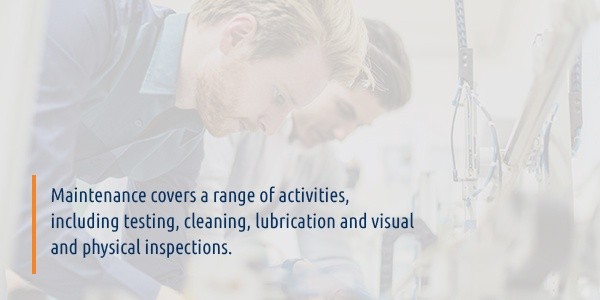Industrial Robot Maintenance

About Industrial Robots | Benefits of Maintaining Your Robots | Maintenance for Industrial Robots | How to Implement a Maintenance Plan
Imagine a workforce that takes no breaks, needs no sleep and makes no mistakes. That is exactly what robots provide. Industrial robots have completely changed the industrial manufacturing world, bringing numerous benefits to the industry and its workforce at large. However, while robots may not need breaks or sleep, they still require care in the form of maintenance to maximize productivity and avoid costly dips in quality or, in worst-case scenarios, complete system shutdowns. If your business is currently or potentially making use of industrial robots, it’s essential to understand preventative maintenance for industrial robots and how to implement it properly.
About Industrial Robots
Robots have quickly become a staple in the industrial manufacturing sector — as of 2017, the Robotic Industries Association estimated that more than 250,000 industrial robots were installed in manufacturing facilities across the United States. In fact, robots have become integral in the U.S. manufacturing industry, helping to keep a greater portion of the manufacturing industry in the United States. This economic importance is due to a few key benefits of implementing industrial robots, such as:
- Improved safety: Humans have natural physical and mental limits — they may tire or get injured when lifting or moving equipment, or they may lose concentration when conducting repetitive tasks. These limits can make it unsafe for laborers to take on certain repetitive or dangerous jobs. By replacing laborers with industrial robots that do not have these limits, workplaces become significantly safer.
- Increased productivity: Between physical limitations and labor laws, humans can only work for a certain number of hours per day before they need a break. For around-the-clock production, multiple people are needed to take on alternating shifts. Robots eliminate this need, working around the clock for as long as they are functional. On average, replacing one key individual on a production line with a robot results in a 40% increase in output.
- Reduced labor costs: Robots eliminate the need for lower-skilled manufacturing jobs by taking on more repetitive and dangerous tasks. Instead of spending money on personnel, including insurance costs, overtime, sick leave and training, companies can invest that money into a robotic workforce. Not only does this improve productivity, but it cuts costs overall, allowing companies to invest money toward higher-level tasks — this has created room in the industry for high-skilled jobs in areas like engineering and product design.
As robots become even faster and cheaper to produce, they’re becoming an ever more popular alternative to unskilled laborers. By using industrial robots, manufacturing companies save their companies money while also producing cheaper products for customers. The key to these benefits, however, is the functionality of these industrial robots.
Benefits of Maintaining Your Robots
To experience the benefits of industrial robots, manufacturers have to regularly maintain them. The most common and most beneficial form of robot maintenance is preventive maintenance, which is regular, planned maintenance that is implemented to avoid damage. Preventive maintenance includes tasks like regular cleaning, lubrication, painting, adjustments and minor replacements, but it may also involve periodic testing and inspections to ensure the robots meet operational standards. While these tasks may seem small, they reap huge benefits, including the following:
- Minimizing downtime: While planned maintenance may halt production temporarily, this saves you from more lost production time in the future. Robot malfunctions take time and money to identify and repair, during which time companies lose thousands of dollars in revenue and productivity. It’s much easier and cheaper to fix a problem during routine maintenance than to fix the same problem after the part has failed and potentially damaged other components.
- Reducing manufacturing time: If regular maintenance isn’t followed, robots may slow down over time due to poor lubrication or worn parts. While the change may not be noticeable, it can add up to substantial amounts of lost time. With regular maintenance, products are made as quickly as possible, without losing time to malfunctioning equipment.
- Improving product quality: Small changes in functionality due to wear and tear can reduce product quality through the introduction of errors. These issues can substantially reduce the quality of products, costing manufacturers in material losses and in customer opinion. By preventing malfunctions and breakdowns, manufacturers can ensure products are made to expected quality levels.
- Reducing energy consumption: Robots with worn down parts or poor lubrication may consume more power than normal to operate. While the changes may initially be small, multiple poorly-maintained robots consuming extra power can result in huge increases in energy costs. By maintaining industrial robots properly, manufacturing companies can ensure they are functioning efficiently, which keeps overhead costs and cost of ownership to a minimum.
- Maximizing equipment lifespans: Preventative maintenance for industrial robots allows manufacturing companies to extend the life of their robots dramatically. With regular maintenance, manufacturers can extend the life of a robot to 20 years, maximizing their return on investment.
All of these factors help maximize productivity and reduce overall costs to manufacturing companies. Additionally, regular maintenance practices can add an aspect of organization to your facilities, encouraging operators to maintain clean and orderly facilities and processes.
Maintenance Items for Industrial Robots
While it’s easy to tell when a robot needs repairing, preventive maintenance is a trickier matter. How often should each part be checked? What timeframe should be followed? Fortunately, there are some general guidelines to provide a basic outline.
Maintenance covers a range of activities, including testing, cleaning, lubrication and visual and physical inspections.

Some of these inspections, like checking parts for wear, are universally applicable. Others, however, are more specific and vary based on the particular model of robot used in your facility. For example, some robots may have a specific control system that requires weekly backup, while another may only require a monthly one. Regardless of the situation, always follow manufacturer specifications when developing a maintenance plan — these can usually be found in your user manual.
Outside of manufacturer-specific guidelines, maintenance items should occur within daily, monthly and annual timeframes, which are explained in more detail below. As discussed above, always follow manufacturer specifications if they are more stringent than the general guidelines provided.
1. Daily Checks
Some essential functions should occur on a daily basis to ensure industrial robots are functioning to standards. These checks are cursory but will catch the majority of glaring problems with industrial robots before they begin their daily operations. These checks are as follows:
- Visually check external components for damage and wear.
- Remove any dust or debris from sensors or optical components.
- Check for grease or oil leaks and clean and refill when necessary.
- Listen for any excessive vibration or unusual noises.
2. Monthly Checks
Monthly checks should be more detailed than daily checks but are still largely superficial. These will catch any operational issues and prevent the majority of problems that occur:
- Clean and ventilate the robot controller’s cooling fans to maximize airflow.
- Back up the robot controller’s memory.
- Complete a visual inspection of the robot in motion, checking the robot, harness and cables.
3. Quarterly Checks
Quarterly checks are even more detailed than monthly checks and focus on safety features and fixtures. These checks include the following:
- Check all connections between the robot and any power supplies, fans or safety equipment.
- Check all unit cables for any kinks, pinch points, cuts, tears or loose connections.
- Tighten all bolts, especially external mounting bolts.
- Detail clean the mechanical unit to remove any chips or debris.
4. Annual Checks
Annual checks should be extremely detailed to cover all aspects of machine functionality. This is the time to review any performance metrics from the last year to see if the machine has shown any signs of slowing down or consuming more power than usual. Some of the checks include the following:
- It is recommended to replace batteries every year in the mechanical unit, RAM, APC and CPU. It is essential to ensure these batteries do not die, since this may cause serious issues in functionality.
- Replace grease and oil and be sure to select options that are recommended by the manufacturer.
- Inspect the operation of the brake to ensure no delays.
- Complete thorough functional tests to make sure the robot meets specifications.
How to Implement a Maintenance Plan for Your Industrial Robots
We’ve covered which maintenance items should be done and approximately when they should be done. Now it’s time to develop and implement a schedule. Follow the steps below to develop and implement a preventative maintenance plan for your industrial robots.
1. Establish a Maintenance Schedule
Every successful maintenance program starts with a strict schedule. The guide above provides an approximate timeline to follow, but the specific timeframes of your schedule should be determined based on the manufacturer specifications of your particular set of equipment. Use the guide above, along with recommendations from the manufacturer’s manual, to develop a detailed plan with daily, monthly and annual items. Follow the manufacturer recommendations when in doubt, but do not be afraid to increase the frequency of maintenance items if they are a point of concern for your industry or application.
2. Implement the Schedule
Once the schedule is complete, it is time to implement the schedule at every level of your organization. This must include the following steps:
- Communicate the schedule: Once set, communicate the schedule to all stakeholders and applicable personnel. This may include posting the schedule for easy viewing in a company bulletin or calendar system. Be sure to review the schedule monthly with personnel to ensure there are no conflicts with the manufacturing flow, customer orders or other company matters — if conflicts occur, reschedule the maintenance day within a realistic timeframe.
- Employee training: When going through annual training, be sure to review maintenance matters with operators. This must include the maintenance schedule and should also impart the importance of preventive maintenance for operational safety.
- Annual scheduling: Each year, review the schedule and set one going into the new year. Make sure major maintenance items are scheduled for days where they will have minimal impact on the manufacturing flow.
Also, keep in mind that no program is perfect — if employees bring up problems, gaps or improvements, these should be taken into serious consideration. Any changes to the plan should be communicated through the above means.
3. Regularly Reassess the Plan
Companies evolve over time, and your maintenance plan needs to evolve with you. It’s important to reassess your preventive maintenance plan regularly, but it’s not always necessary to review it on an annual basis. Instead, consider whether your company has undergone recent changes — if your company is experiencing any of the following events, it may be prudent to reassess your maintenance program:
- Introduction of new equipment
- Expansion of automation
- Recent production delays or reductions in quality
- Increased need for high-quality products
- Excessive energy consumption
- Changes in staff or floor organization
If your company encounters any of the above situations, it is time to bring together your decisionmakers and essential staff to determine a new maintenance schedule.
4. Find Experts to Make Repairs
On top of all the factors previously listed, it is essential to consider working with specialists in industrial robot maintenance. These specialists can help you with regular maintenance tasks as well as help you assess your preventive maintenance schedule and develop one tailored to your company’s specific needs.
While having repair personnel on staff may be convenient, it can be expensive, especially for smaller manufacturing companies. Instead, consider working with experienced professionals who know your robots and processes from the inside out. Global Electronic Services is one such company, offering a time-tested and approved process for maintaining all of your company’s industrial robots.
Choose GES Repair Services
U.S. companies choose to work with industrial robots to increase efficiency, but robots must they’re working properly to achieve that efficiency. Industrial robot malfunctions can kill efficiency by shutting down your entire operation, increasing costs and turnaround times. Fortunately, if you need a solution in robot repair or preventive maintenance, Global Electronic Services can help.
Global Electronic Services is the best choice for industrial robot maintenance and repair services. Our certified repair technicians are factory trained and have experience with a range of industrial robots, including models from Fanuc, Motoman, ABB and ASI Robotics, as well as other brands. They’re also extremely thorough with their testing — they ensure every part is repaired, every problem is solved and that your robot works to perfection. We’re so confident in the competence of our technicians that we offer an industry-leading 18-Month In-Service Warranty.
On top of our technical competence, we offer speed and value. Our rush repair service will have your robot back in one or two days, and even our standard services have a turnaround of five days or less. All of these services are offered with excellent value — we provide fair prices and accurate estimates so you know what to expect. We also offer a Global Price Guarantee — if you can find a lower price from a competitor, we’ll beat it by 10 percent.
Don’t put off robotics repair or trust the maintenance of your robotics to just anyone. Global Electronic Services is here to take all those concerns off the table. We’re ready to get you and your robots back to work. To get started, contact us online for a free quote or call us at 877-249-1701 to learn more about our services.
